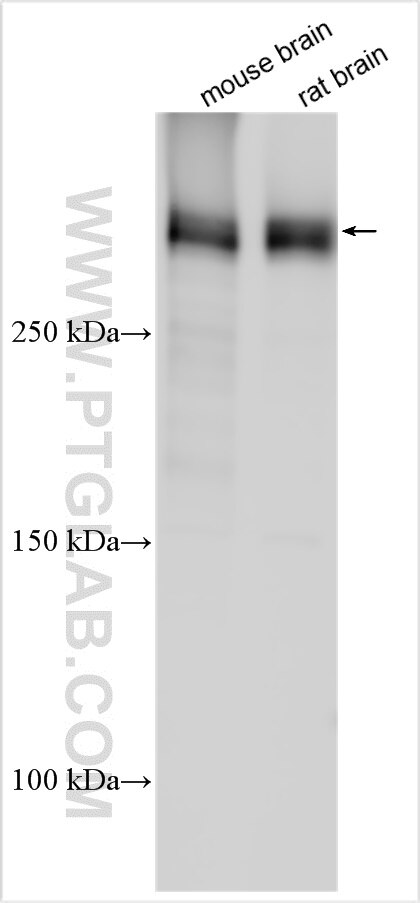Tested Applications
| Positive WB detected in | mouse brain tissue, rat brain tissue |
Recommended dilution
| Application | Dilution |
|---|---|
| Western Blot (WB) | WB : 1:500-1:1000 |
| It is recommended that this reagent should be titrated in each testing system to obtain optimal results. | |
| Sample-dependent, Check data in validation data gallery. | |
Product Information
31573-1-AP targets CSMD2 in WB, ELISA applications and shows reactivity with Human, mouse, rat samples.
| Tested Reactivity | Human, mouse, rat |
| Host / Isotype | Rabbit / IgG |
| Class | Polyclonal |
| Type | Antibody |
| Immunogen | CSMD2 fusion protein Ag36106 Predict reactive species |
| Full Name | CUB and Sushi multiple domains 2 |
| Calculated Molecular Weight | 380kDa |
| Observed Molecular Weight | 380 kDa |
| GenBank Accession Number | NM_001281956 |
| Gene Symbol | CSMD2 |
| Gene ID (NCBI) | 114784 |
| RRID | AB_3670040 |
| Conjugate | Unconjugated |
| Form | Liquid |
| Purification Method | Antigen affinity Purification |
| UNIPROT ID | Q7Z408 |
| Storage Buffer | PBS with 0.02% sodium azide and 50% glycerol , pH 7.3 |
| Storage Conditions | Store at -20°C. Stable for one year after shipment. Aliquoting is unnecessary for -20oC storage. 20ul sizes contain 0.1% BSA. |
Background Information
CUB and sushi multiple domains 2 (CSMD2), located on the short arm of human chromosome 1 (1p35.1), encodes a single-pass transmembrane protein with a large extracellular domain consisting of CUB and Sushi domain repeats. CSMD2 is highly expressed in the developing and mature brain and has been linked to schizophrenia (PMID:31068362). The full-length molecular weight of CSMD2 protein is 380 kDa.
Protocols
| Product Specific Protocols | |
|---|---|
| WB protocol for CSMD2 antibody 31573-1-AP | Download protocol |
| Standard Protocols | |
|---|---|
| Click here to view our Standard Protocols |



